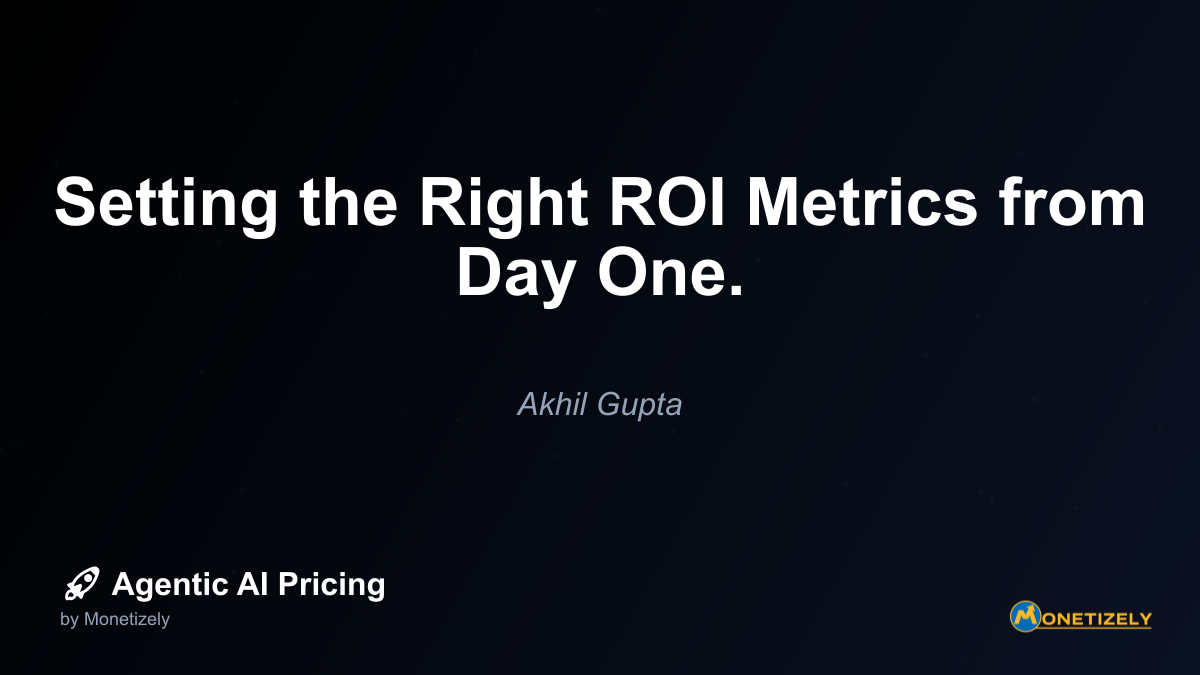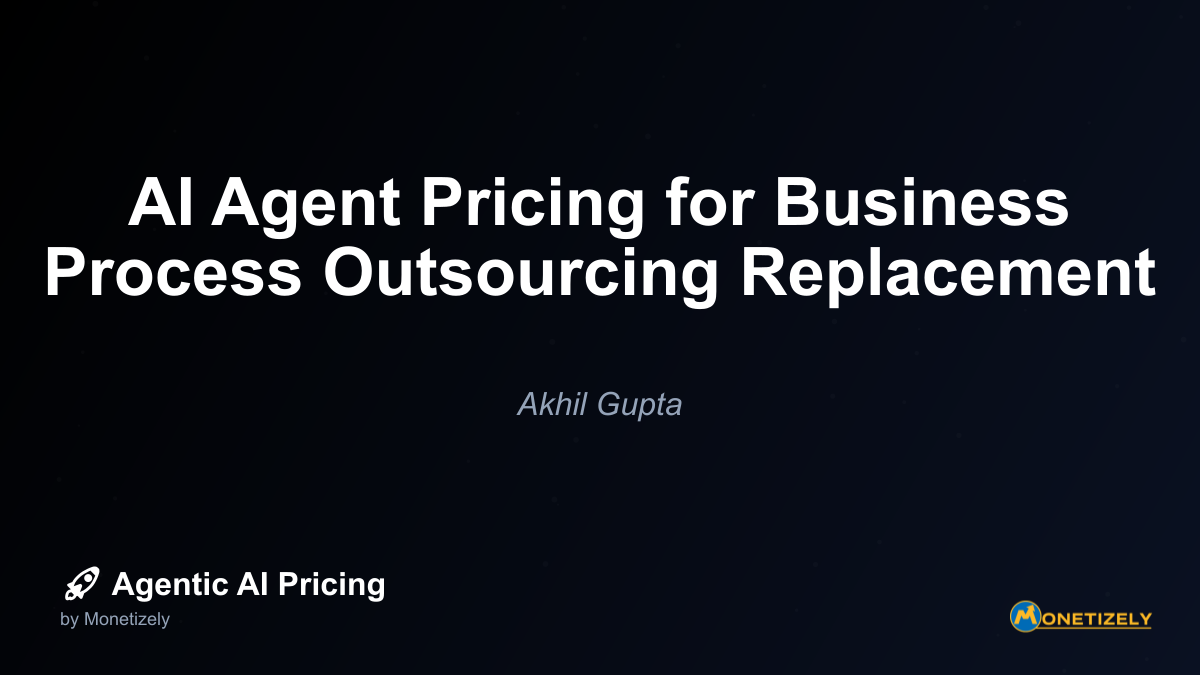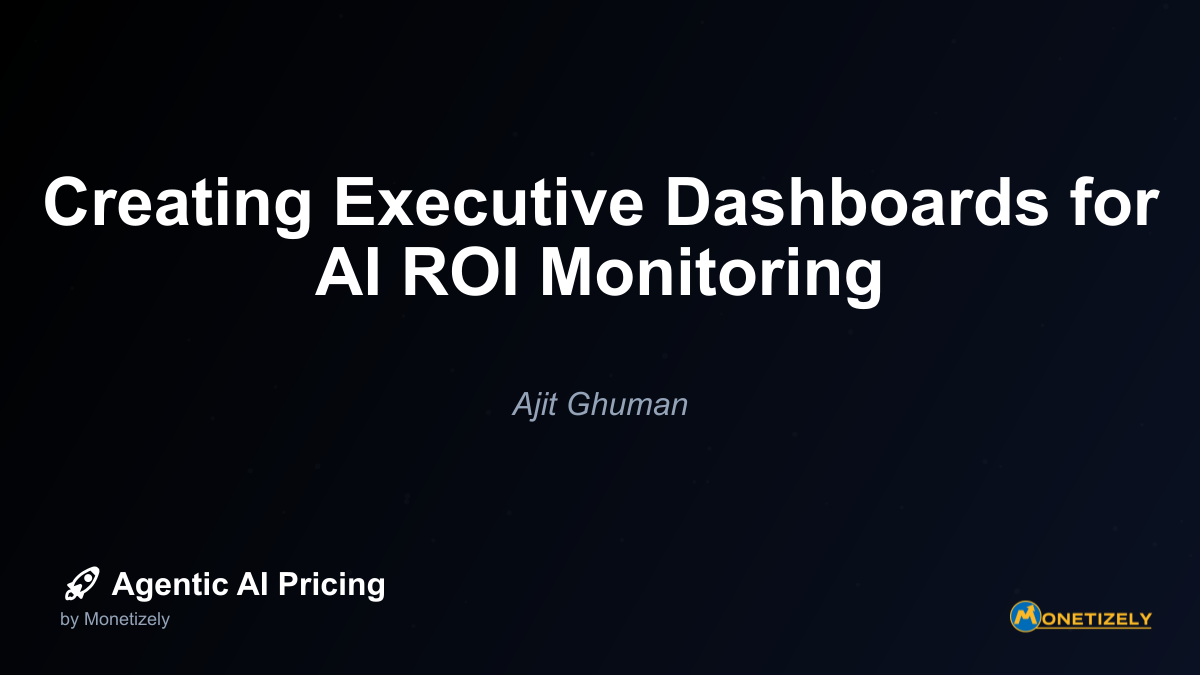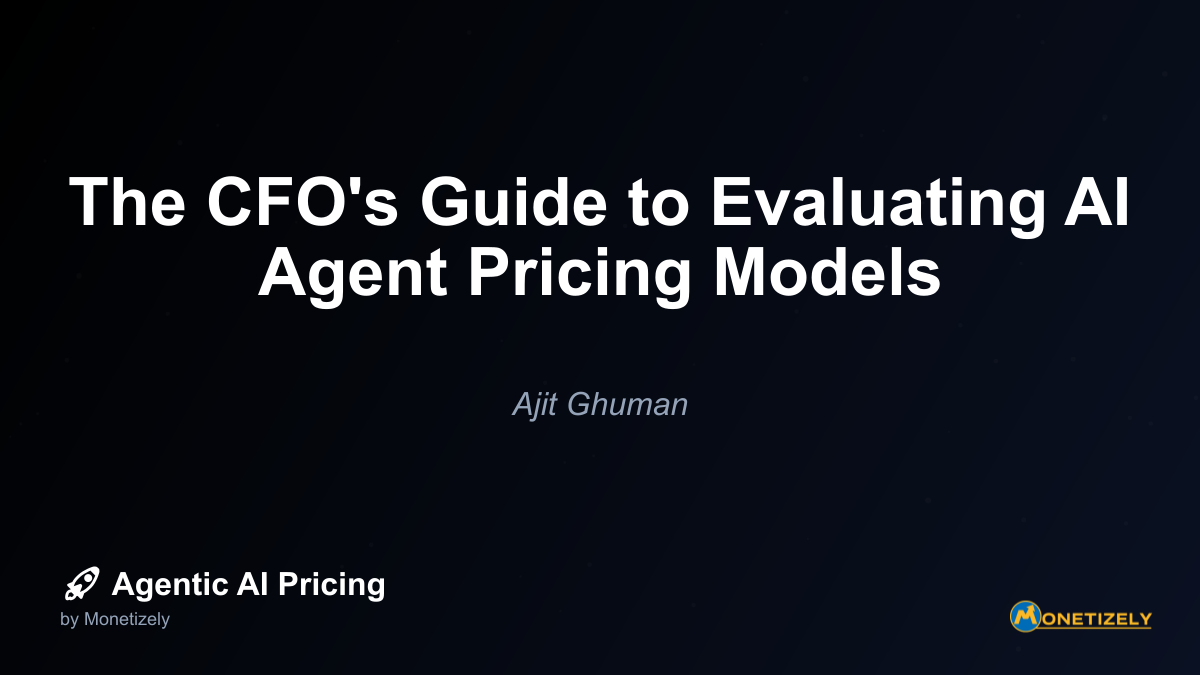· Akhil Gupta · ROI and Value · 10 min read
Setting the Right ROI Metrics from Day One.
AI and SaaS Pricing Masterclass
Learn the art of strategic pricing directly from industry experts. Our comprehensive course provides frameworks and methodologies for optimizing your pricing strategy in the evolving AI landscape. Earn a professional certification that can be imported directly to your LinkedIn profile.

In today’s competitive business landscape, organizations are increasingly turning to artificial intelligence (AI) solutions to drive efficiency, innovation, and growth. However, many AI initiatives fail to deliver their expected value not because of technological shortcomings, but due to a fundamental oversight: the absence of clearly defined success metrics from the outset. Establishing appropriate Return on Investment (ROI) metrics before launching an AI project is not merely a good practice—it’s essential for meaningful evaluation, stakeholder alignment, and ultimate success.
Why ROI Metrics Matter from Day One
The enthusiasm surrounding AI implementations often overshadows the critical groundwork of establishing measurement frameworks. Organizations eager to embrace cutting-edge technologies may rush into development without answering fundamental questions: What specific business problems are we solving? How will we quantify success? What baseline are we improving upon?
This oversight creates a precarious situation where substantial investments are made without clear parameters for evaluating their effectiveness. Without predefined metrics, organizations risk falling into the “AI for AI’s sake” trap, where technology becomes an end rather than a means to achieve business objectives.
Defining ROI metrics from the beginning serves multiple crucial purposes:
- Creates alignment across stakeholders - From executives to end-users, everyone understands what the AI initiative aims to accomplish
- Establishes accountability - Teams have clear targets to work toward
- Enables data-driven decision-making - Objective measurements replace subjective impressions
- Facilitates course correction - Deviations from expected performance can be identified early
- Justifies continued investment - Demonstrated value supports ongoing resource allocation
The Cost of Delayed Metric Definition
When organizations postpone establishing ROI metrics, they encounter several significant challenges:
Post-Implementation Measurement Difficulties
Attempting to retroactively measure ROI after implementation presents numerous complications. Without baseline measurements captured before deployment, organizations lack the comparative data needed to demonstrate improvement. This creates a “before and after” gap that makes quantifying the AI’s impact nearly impossible.
Furthermore, post-hoc metric selection often suffers from confirmation bias, where teams unconsciously choose metrics that validate their work rather than those that objectively assess business value. This undermines the credibility of reported results and can lead to misguided future investments.
Stakeholder Misalignment
Without predefined success criteria, different stakeholders develop their own expectations for what constitutes success. Executive leadership might focus on cost reduction, while operations teams prioritize efficiency gains, and end-users emphasize improved experience. These divergent perspectives inevitably lead to conflicting assessments of the AI’s value.
As one project leader at a Fortune 500 company noted after a failed AI implementation: “We thought we were building exactly what the business wanted, only to discover they had an entirely different definition of success in mind.”
Resource Inefficiency
Perhaps most critically, the absence of clear metrics leads to inefficient resource allocation. Development teams may invest significant time and effort optimizing for factors that don’t meaningfully contribute to business objectives. This misalignment between technical development and business goals results in wasted resources and missed opportunities.
Essential Components of Effective ROI Metrics
Developing meaningful ROI metrics requires careful consideration of several key elements:
Baseline Establishment
Every meaningful measurement begins with understanding the current state. Baseline metrics document existing performance levels before AI implementation, providing the foundation for comparison. These baselines should:
- Be measured using consistent methodologies that can be replicated post-implementation
- Capture sufficient historical data to account for normal variations
- Include both quantitative measures (e.g., processing times, error rates) and qualitative aspects (e.g., user satisfaction)
- Be documented with clear metadata explaining measurement conditions and limitations
For example, a financial institution implementing AI for fraud detection should first establish baseline metrics like:
- Current false positive rate (legitimate transactions flagged as suspicious)
- Current false negative rate (fraudulent transactions missed)
- Average time to resolve flagged transactions
- Customer satisfaction scores related to fraud prevention measures
These baseline measurements provide the reference point against which the AI solution’s impact will be evaluated.
Target Value Definition
With baselines established, organizations must next define target values that represent success. These targets should be:
- Specific - Precisely defined to avoid ambiguity
- Measurable - Quantifiable using available data
- Achievable - Realistic given the capabilities of the technology
- Relevant - Directly tied to business objectives
- Time-bound - Associated with a clear timeframe
Rather than vague goals like “improve efficiency,” effective target metrics specify “reduce document processing time by 35% within six months of implementation.” This precision enables objective evaluation of success.
Measurement Methodology
Beyond what to measure, organizations must define how measurements will be conducted. This methodology should address:
- Data sources and collection methods
- Measurement frequency and timing
- Statistical approaches for analysis
- Responsibilities for data collection and reporting
- Procedures for addressing measurement challenges
Documenting these methodological decisions ensures consistency between baseline and post-implementation measurements, strengthening the validity of reported results.
Categories of ROI Metrics for AI Initiatives
Effective ROI frameworks typically include metrics across multiple categories to capture the full impact of AI implementations:
Financial Metrics
While not always the easiest to measure initially, financial metrics ultimately drive business decisions:
- Cost reduction - Decreased operational expenses, reduced error-related costs
- Revenue enhancement - Increased sales, improved customer retention
- Profit margin improvement - Enhanced efficiency leading to greater profitability
- Time-to-value - How quickly the AI solution delivers positive returns
For example, an AI-powered customer service solution might track:
- Reduction in support staff costs
- Decreased customer churn due to improved service
- Increased cross-selling through AI-powered recommendations
Operational Metrics
Operational metrics focus on process improvements and efficiency gains:
- Productivity enhancement - Output per employee or time unit
- Error reduction - Decreased mistake rates in processes
- Processing time - Reduced cycle times for key workflows
- Automation rate - Percentage of tasks successfully automated
A manufacturing company implementing predictive maintenance AI might measure:
- Reduction in unplanned downtime
- Decrease in maintenance costs
- Improved equipment lifespan
- Increased production throughput
Customer Experience Metrics
AI often significantly impacts customer interactions and satisfaction:
- Customer satisfaction scores - Direct feedback measurements
- Net Promoter Score (NPS) - Likelihood of customer recommendations
- Resolution rates - First-contact problem solving
- Response times - Speed of addressing customer needs
An e-commerce company deploying an AI recommendation engine would track:
- Improvement in customer satisfaction ratings
- Increased time spent on site
- Higher average order values
- Reduced cart abandonment rates
Strategic Metrics
Beyond immediate operational improvements, AI can deliver strategic advantages:
- Market share changes - Competitive positioning
- Innovation capabilities - New product/service development
- Organizational agility - Improved response to market changes
- Talent acquisition and retention - Enhanced employer brand
A pharmaceutical company leveraging AI for drug discovery might measure:
- Reduction in research cycle time
- Increased number of promising compounds identified
- Improved clinical trial success rates
- Enhanced intellectual property portfolio
Creating a Comprehensive ROI Framework
Developing an effective ROI framework involves a structured approach that begins well before AI implementation:
Step 1: Align with Business Objectives
All metrics should connect directly to organizational priorities. This alignment process involves:
- Identifying key business objectives the AI initiative supports
- Determining which metrics best reflect progress toward these objectives
- Prioritizing metrics based on their strategic importance
- Ensuring executive stakeholders endorse the selected metrics
This alignment prevents the common pitfall of measuring what’s easy rather than what’s important.
Step 2: Involve Cross-Functional Stakeholders
Effective metric development requires input from diverse perspectives:
- Business leaders - Provide strategic context and priorities
- Finance teams - Ensure metrics can translate to financial impact
- Operations staff - Offer insights on practical measurement challenges
- End users - Highlight adoption and usability considerations
- IT and data teams - Advise on data availability and collection methods
This collaborative approach ensures metrics reflect the priorities of all stakeholders while remaining practically measurable.
Step 3: Document and Communicate
Once metrics are defined, comprehensive documentation is essential:
- Create a formal ROI measurement plan
- Define each metric with precise calculation methodologies
- Establish measurement responsibilities and timelines
- Develop reporting formats and frequencies
- Communicate the framework to all relevant stakeholders
This documentation serves as the reference point throughout implementation and evaluation.
Common Pitfalls in ROI Metric Definition
Even organizations that recognize the importance of early metric definition can encounter several common challenges:
Overemphasis on Quantitative Metrics
While quantitative metrics provide concrete measurements, overreliance on numbers alone can miss critical qualitative impacts. An AI solution might deliver impressive efficiency gains while simultaneously creating user frustration that undermines long-term adoption.
Balanced frameworks include both quantitative measures and qualitative assessments like user satisfaction, perceived value, and cultural impact.
Metric Proliferation
In an effort to be comprehensive, organizations sometimes define too many metrics, creating measurement burden and diluting focus. Effective frameworks typically include:
- 3-5 primary metrics that directly reflect core business objectives
- 5-10 secondary metrics that provide supporting insights
- Clear prioritization among metrics to guide decision-making
This focused approach ensures attention remains on the most significant impacts.
Neglecting Indirect Benefits
Many AI implementations deliver substantial value through indirect benefits that may not appear in initial ROI calculations. For example, an AI-powered knowledge management system might show modest direct productivity improvements while significantly enhancing innovation capabilities through improved knowledge sharing.
Comprehensive frameworks include mechanisms for capturing these indirect benefits, even if they’re initially harder to quantify.
Failing to Adapt Metrics Over Time
As AI implementations mature, appropriate metrics often evolve. Initial metrics might focus on adoption and technical performance, while later measurements shift toward business impact and strategic advantage.
Effective frameworks include planned review points to reassess and potentially revise metrics as the implementation progresses.
Real-World Success Stories
Organizations that establish clear ROI metrics from day one consistently report more successful AI implementations:
Financial Services: AI-Powered Loan Processing
A regional bank implemented AI to streamline loan application processing. Before development began, they established baseline metrics including:
- Average processing time: 7.2 days per application
- Manual review requirement: 68% of applications
- Error rate: 4.3% requiring rework
- Customer satisfaction: 72% positive
Target metrics were set at:
- Processing time: 2 days or less (72% reduction)
- Manual review: Below 30% of applications
- Error rate: Under 1%
- Customer satisfaction: Above 90%
By establishing these metrics upfront, development teams prioritized features with the greatest impact on target outcomes. Eight months after implementation, the bank achieved:
- Processing time: 1.8 days (75% reduction)
- Manual review: 23% of applications
- Error rate: 0.7%
- Customer satisfaction: 94%
The clear metrics enabled the bank to demonstrate a 290% ROI within the first year, justifying expanded AI investments in other business areas.
Healthcare: Predictive Patient Management
A hospital network implementing AI for patient flow optimization began by documenting baseline metrics:
- Average emergency department wait time: 76 minutes
- Bed utilization rate: 82%
- Patient transfer time: 164 minutes
- Staff overtime hours: 12.3% of total hours
They established target metrics of:
- Wait time reduction: 40% improvement
- Bed utilization: 92% optimal usage
- Transfer time: 50% reduction
- Overtime reduction: 30% decrease
This clarity enabled focused development and change management. Eighteen months post-implementation, the hospital network reported:
- 52% reduction in wait times
- 94% optimal bed utilization
- 62% faster patient transfers
- 38% reduction in overtime costs
The well-defined metrics not only demonstrated clear success but also helped identify specific workflow adjustments needed to maximize the AI’s impact.
Practical Implementation Guide
For organizations preparing to launch AI initiatives, the following step-by-step approach ensures proper metric definition from day one:
Phase 1: Pre-Development (1-2 Months Before Project Launch)
- Conduct stakeholder workshops to identify business objectives and potential metrics
- Document current state processes to establish accurate baselines
- Collect baseline measurements using consistent, replicable methodologies
- Define target metrics with specific improvement goals
- Create measurement plans detailing data sources and collection methods
Phase 2: During Development
- Incorporate measurement capabilities into the AI solution architecture
- Establish data collection mechanisms for ongoing metric tracking
- Conduct interim measurements to assess progress toward targets
- Refine metrics based on early implementation insights
Phase 3: Post-Implementation
- Execute the measurement plan according to defined timelines
- Compare results to baseline and target metrics
- Document both anticipated and unanticipated impacts
- Communicate results to all stakeholders
- Iterate on the solution based on metric-driven insights
Conclusion: The Competitive Advantage of Metric-Driven AI
In an era where AI investments continue to grow exponentially, the difference between success and failure increasingly depends not on the technology itself but on how organizations approach implementation. Establishing clear ROI metrics from day one provides a significant competitive advantage through:
- Enhanced decision-making - Objective measurements replace subjective assessments
- Improved resource allocation - Investments flow to initiatives with demonstrable impact
- Accelerated value realization - Focus remains on business outcomes rather than technical capabilities
- Greater organizational alignment - Shared metrics create common purpose across functions
Organizations that master this metric-driven approach position themselves to extract maximum value from their AI investments while avoiding the disappointment of technically impressive but business-irrelevant implementations.
By establishing comprehensive baseline measurements, defining specific target values, and creating robust measurement methodologies before development begins, organizations create the foundation for AI initiatives that deliver meaningful, measurable business impact. In the rapidly evolving AI landscape, this disciplined approach to ROI measurement may ultimately prove more valuable than any specific technological advantage.
Co-Founder & COO
Akhil is an Engineering leader with over 16+ years of experience in building, managing and scaling web-scale, high throughput enterprise applications and teams. He has worked with and led technology teams at FabAlley, BuildSupply and Healthians. He is a graduate from Delhi College of Engineering and UC Berkeley certified CTO.
Pricing Strategy Audit
Let our experts analyze your current pricing strategy and identify opportunities for improvement. Our data-driven assessment will help you unlock untapped revenue potential and optimize your AI pricing approach.




